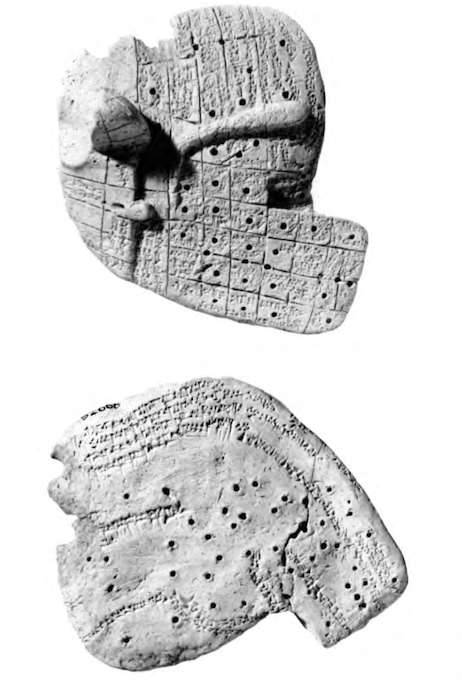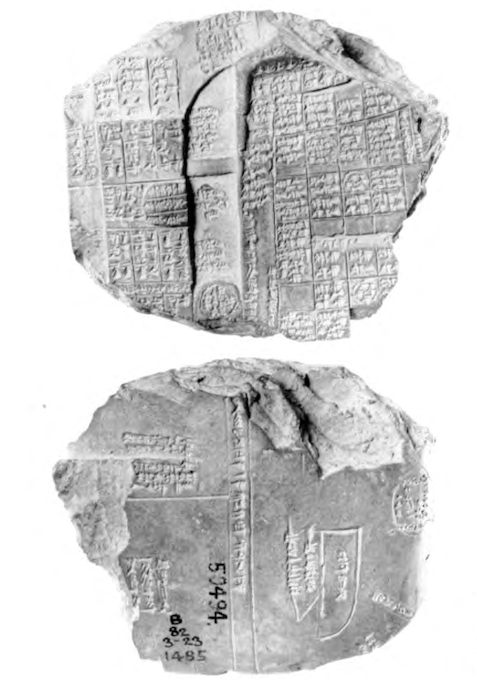The Practice of Extispicy
For the reasons outlined above, extispicy remained indispensable to the Sargonid kings in eliciting divine response to their queries. No other group of specialists operating at the time could render such service in determining the advisability of any course of action to be taken by these monarchs, be it in the realm of international diplomacy or in domestic affairs. The record of the diviners' activity on behalf of Esarhaddon and Assurbanipal is found in the extispicy reports embedded in the corpus of texts under discussion. Such reports, which are in reality records of autopsies performed on dead sacrificial sheep, consist of observations, rather like those of the modern pathologist, of the physical condition of the exta of these animals.
The tradition of recording autopsies of dead sacrificial sheep remained remarkably consistent in Mesopotamia from the Old Babylonian to the Neo-Assyrian times.[[89]] In spite of the time gap separating the two periods, as well as certain technical changes in the practice and nomenclature of extispicy which came about in the course of time, the observations in the Sargonid reports and queries differ only slightly, with respect to the parts of the exta inspected and the technical terminology employed, from those of the Old and Middle Babylonian reports available to us.
The entire exta of the sheep came under scrutiny in these autopsies, but the starting point of the diviner's inspection was the liver. Here liver models have been as helpful to the modern investigator as they must have been to the apprentice diviner in ancient Mesopotamia. We are fortunate in having a comparatively large number of such models, both from Mesopotamia and elsewhere in the Near East. The major parts of the liver, such as the umbilical fissure, the gall bladder, the caudate lobe, etc., are marked on all extant liver models, and have been most helpful in the identification of the Akkadian terms for these parts.[[90]]
The parts of the exta of the sheep making their appearance in the omen texts and extispicy reports may be divided into two groups:
1) Anatomical or "fixed" parts, i.e., those parts of the sheep's anatomy, such as the liver, lungs, heart, intestines etc., or parts thereof, such as the gall bladder and caudate lobe of the liver, the accessory lobe of the right lung, the coils of the colon, etc., and their surrounding "territories," whose location on the exta when in normal condition is fixed by virtue of their being either constituent parts of the sheep's anatomy (parties constitutives in Nougayrol's terminology),[[91]] or were so considered by the diviner.
Four markings in particular, which usually appear as creases or fissures on the surface of liver models, were considered parts of the liver whose presence was expected in much the same way as that of the gall bladder, umbilical fissure, and caudate lobe. Their presence or absence and physical condition were recorded as standard observations in extispicy reports from the OB to the NA period. These four markings on the liver were known in Akkadian as naplastu/manzāzu, padānu, danānu and šulmu, meaning 'station,' 'path,' 'strength,' and 'well-being,' respectively. It was the absence of any of these or any other part of liver, their dislocation from their normal position, or any other abnormality observed on them by the haruspex which made them omi- nous, and predictions were derived from their abnormalities.

FIG. 6a, b. Liver model with annotations (Old Babylonian). BM 92668.

FIG. 7a, b. Liver model with annotations (Neo-Assyrian?). BM 50494
2) Fortuitous markings (parties fortuits, in Nougayrol's terminology), such as holes, abrasions, blisters, scars, fissures, and a host of others, whose presence and condition was equally ominous, could be found anywhere on the exta. Some of these markings, such as 'weapon'-marks, 'foot'-marks, cross-shaped marks, etc., owe their names to their peculiar configurations, some of which appear in drawings found in omen texts and extispicy reports.[[92]] or were so considered by the diviner.
89 For the NB period, notably the reign of Nabonidus, see my remarks in Starr Rituals, p. 126.
90 For a brief discussion of the anatomy of the liver, see Starr Rituals, p. 77.
91 Ulla Jeyes refers to these parts, following Nougayrol, as "zones" (JCS 30 [1978] 204).
92 E.g., CT 31 9 ('weapon'-mark); KUB 7 7 ('foot'-mark), etc.
Ivan Starr
Ivan Starr, 'The Practice of Extispicy', Queries to the Sungod: Divination and Politics in Sargonid Assyria, SAA 4. Original publication: Helsinki, Helsinki University Press, 1990; online contents: SAAo/SAA04 Project, a sub-project of MOCCI, 2020 [http://oracc.org/saao/saa04/thepracticeofextispicy/]